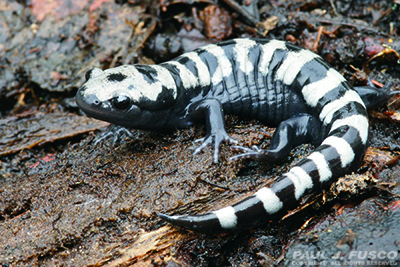Marbled Salamander
Ambystoma opacum

Background and Range: The marbled salamander is in the family Abystomatidae, which includes the large, stout-bodied mole salamanders. These salamanders are widely distributed in Connecticut but absent from high elevations (above 1,100 feet). They are locally common on the trap rock ridges of the Central Connecticut Lowland. This southern species reaches its northeastern range limit in Massachusetts and the mid-Hudson Valley of New York. It ranges over much of the eastern United States, but is absent from many areas.
Description: This chunky and compact salamander ranges in length from approximately 3 to 4.75 inches (70-120mm). The tail is stubby, and not as well developed as the other mole salamanders. The marbled salamander is one of Connecticut's more distinctively marked salamanders: males have bright white bands on a black body, while females have grayish-white bands on black. The underside is black. Females are larger than males. Newly transformed young have purplish-gray marbling, which will transform with age. Larvae range from dark gray or black and have light spots of bands on the sides. Larvae have external gills which help distinguish them from frog tadpoles.
Habitat and Diet: Marbled salamanders are found in or around deciduous woodlands. However, water or moist areas are usually close by. These salamanders prefer dry, sandy-soiled habitats and even rocky slopes, but they also may be found in wet, swampy soils. They usually hide under rocks and logs on wooded slopes.
Marbled salamanders feed on worms, slugs, snails, spiders, millipedes, crickets, beetles, ants, and other invertebrates. The larger larval marbled salamanders feed on spotted salamander larvae and wood frog tadpoles, as well as zooplankton.
Life History: Marbled salamanders emerge from their underground homes in early fall to migrate to their breeding grounds. This is opposite from other mole salamanders that breed during early spring. The marbled salamander is the only member of the Ambystomatidae family to breed on land and not in the water. Males typically precede females to a dried-up site that will fill with water after a big rain. Once there, they deposit packets of sperm (technically known as spermatophores). When the females arrive to the breeding grounds, they deposit between 30 to over 200 eggs underneath moist vegetation or debris. The duration of the larval cycle is dependent on weather and habitat type; it often is timed with the autumn filling of dried temporary pools. Females may remain with the eggs, brooding them until the pools fill with water. Typically, marbled salamander larvae have transformed and are ready to emerge from the wetlands by the time spotted salamanders begin their reproductive cycles in the spring.
Adults hibernate underground during winter in areas not too far from breeding sites. Adults will also avoid high summer heat by aestivating.
Interesting Facts: These salamanders move primarily at night to decrease competition with other species and avoid predation risks. Recently transformed young will wait for a rainy night before migrating away from the breeding site.
A noxious substance that deters many would-be predators is secreted from the skin of the marbled salamander.
Conservation Concerns: Marbled salamanders prefer undisturbed habitats and are less tolerant of areas with human presence and development. Often, buffered protection of seasonal, temporary pools will provide refuge for marbled salamanders and other species that rely on these pools. This protection is important because terrestrial ranges are usually close to breeding sites.
What You Can Do
If you find a marbled salamander in the wild, leave it where you found it and only take photographs. Every individual is vitally important to its local population.
Consider proper habitat management practices if your property contains successful vernal pools where marbled salamanders breed. The Vernal Pool Association website, at www.vernalpool.org, is a good place to start your research.
Urge your town to install amphibian tunnels at migration hotspots that overlap roads. If you are fortunate enough to witness a mass spring migration, you can help move salamanders from one side of the road to the other, as long as it is completely safe to do so. This can be done with gloves and small buckets as to not stress the salamanders or be exposed to any secretions.
Spread the word about salamanders! Knowledge is often the best tool for conserving these important amphibians.
Additional information about salamanders is available on the Salamanders of Connecticut webpage.
Content last updated on October 11, 2016.

